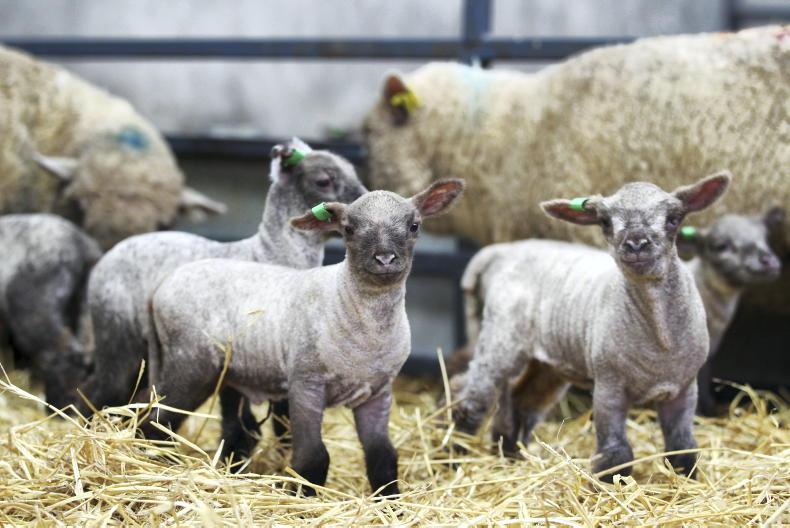Recent analysis conducted by Sheep Ireland and Teagasc has found that five-star sheep are outperforming their one-star counterparts.
The five-star animals are producing more lambs and these lambs are performing better, all while being more environmentally friendly.
The analysis was conducted using the Teagasc Lamb Production Model (TLPM), which is a computer model that simulates an Irish sheep farm to study the effect of varying inputs on flock performance and profitability. The outputs of the TLPM were then combined with a life-cycle analysis model to predict the greenhouse gas (GHG) production from each flock.
Data
This analysis was based on three years of data collected from the Sheep Ireland central progeny testing (CPT) flocks and the Ovidata flocks as well as data from the Teagasc research demonstration flock in Athenry. The CPT and Ovidata flocks provide an invaluable resource to collect data from commercial sheep farms and provide an opportunity to see how €uro-Star ratings work in a commercial setting.
The TLPM simulated a 20ha farm with a stocking rate of 12 ewes per hectare, in line with the data available from Teagasc Athenry. The two scenarios were a flock of one-star ewes mated to one-star rams and a flock of five-star ewes mated to five-star rams.
Each flock had a 22% replacement rate, meaning a proportion of the flock was mated to a one- or five-star replacement sire, with the remainder being mated to a one- or five-star terminal sire. Due to the higher weaning rate of the five-star flock, fewer ewes (38%) were mated to the replacement sire compared to the one-star flock (40%).
Scanning rate
The five-star flock had a higher scanning rate (1.89 v 1.75 lambs per ewe joined) and higher lamb survival rate than their one-star counterparts, resulting in an additional 36 lambs being weaned.
As well as weaning more lambs, the five-star flock had better lamb performance, with greater lamb weights at 40, 100 and 150 days of age. The improved lamb performance resulted in lambs being drafted for slaughter eight days earlier on average, which reduced flock costs and improved average lamb price.
The increased output and performance of the five-star flock increased farm net profit by €154/ha, highlighting the additional profit available from selecting for superior genetics.
The TLPM predicted the grass growth, fertiliser and concentrate requirement of each flock and this was used along with the methane production from the animals to calculate the carbon equivalent output of each system.
The one-star flock produced 9.35t of CO2 equivalent per hectare while the five-star flock produced 9.32t. The difference per hectare is small but when we consider the five-star flock is producing an extra 1.8 lambs per hectare, the higher efficiency of the five-star flock becomes apparent. When broken down to a carcase level, the one-star flock produced 22.1kg of CO2 per kg of lamb carcase, while the five-star flock produced 21kg of CO2 per kg of carcase, a 5% reduction in GHG emissions.
As with all aspects of agriculture, the sheep industry will have to adapt to the new environmental restrictions that are coming down the track and this study shows that choosing genetically superior sheep that produce lamb more efficiently will help to reduce the GHG emissions from the sector.
While there is little difference in the CO2 output per hectare, there is a sizeable difference in CO2 output per kg of carcase and, more importantly, to the farmer per unit of net profit.
Profit
The one- and five-star flocks had a net profit of €8,782 and €11,860, respectively, and produced 21.02t and 16.14t of CO2 per €1,000 net profit, respectively.
This equates to 23% less GHG emissions per €1,000 net profit, highlighting that by selecting for the genetically superior animals, sheep farmers can increase profit and reduce GHG emissions at the same time. Many other sectors have looked at reducing the intensity of production, which can lead to a reduction in profitability. However,this study has shown that choosing the genetically elite animals increases productivity and profitability while reducing GHG emissions.
The results of this study are very promising, but this is just the start, with the next step being to include the options of using protected urea as a nitrogen source and clover inclusion in grass swards to reduce the amount of nitrogen required, both of which will reduce the overall CO2 produced per kg of carcase.
Ongoing work in Teagasc Athenry studying the methane production of sheep will also help to select for the most methane-efficient animals, which will increase the difference between the highly efficient and the less efficient animals even further.






 This is a subscriber-only article
This is a subscriber-only article










SHARING OPTIONS: